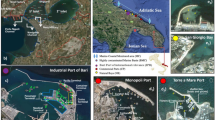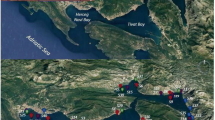Abstract
Pollution levels, pollutant distribution and potential source assessments based on multivariate analysis (chemometrics) were made for harbour sediments from two Arctic locations; Hammerfest in Norway and Sisimiut in Greenland. High levels of heavy metals were detected in addition to organic pollutants. Preliminary assessments based on principal component analysis (PCA) revealed different sources and pollutant distribution in the sediments of the two harbours. Tributyltin (TBT) was, however, found to originate from point source(s), and the highest concentrations of TBT in both harbours were found adjacent to the former shipyards. Polyaromatic hydrocarbons (PAH) ratios and PCA plots revealed that the predominant source in both harbours was pyrogenic related to coal/biomass combustion. Comparison of commercial polychlorinated biphenyls (PCB) mixtures with PCB compositions in the sediments indicated relation primarily to German, Russian and American mixtures in Hammerfest; and American, Russian and Japanese mixtures in Sisimiut. PCA was shown to be an important tool for identifying pollutant sources and differences in pollutant composition in relation to sediment characteristics.







Similar content being viewed by others
References
Akvaplan-Niva (2008). Storvatn in Hammerfest Municipality. Envrionmental investigations of pollutants in water, sediment and fish (Norwegian). www.hammerfestkommune.no.
AMAP (2002). Arctic Monitoring Assessment Program 2002 Heavy metals in the Arctic. www.amap.no, AMAP.
Anezaki, K., & Nakano, T. (2014). Concentration levels and congener profiles of polychlorinated biphenyls, pentachlorobenzene, and hexachlorobenzene in commercial pigments. Environmental Science and Pollution Research, 21, 998–1009.
Carlson, R., & Carlson, J. E. (2005). Design and optimisation in organic synthesis. Amsterdam: Elsevier.
Cheng, I., Lu, J., & Song, X. (2009). Studies of potential sources that contributed to atmospheric mercury in Toronto, Canada. Atmospheric Environment, 43, 6145–6158.
Commission, E. (2012). Joint Communication to the European Parliament and the Council - Developing a European Union Policy towards the Arctic Region progress since 2008 and next steps. In E. Commission (Ed.). European Commission, pp. 1-18.
Countway, R. E., Dickhut, R. M., & Canuel, E. A. (2003). Polycyclic aromatic hydrocarbon (PAH) distributions and associations with organic matter in surface waters of the York River, VA Estuary. Organic Geochemistry, 34, 209–224.
Danish EPA (2005). Guidelines for storage of dredged sediments - capping (Danish). In M. D. EPA) (Ed.).
De Luca, G., Furesi, A., Leardi, R., Micera, G., Panzanelli, A., Costantina Piu, P., & Sanna, G. (2004). Polycyclic aromatic hydrocarbons assessment in the sediments of the Porto Torres Harbor (Northern Sardinia, Italy). Marine Chemistry, 86, 15–32.
Evenset, A., Christensen, G. N., Skotvold, T., Fjeld, E., Schlabach, M., Wartena, E., & Gregor, D. (2004). A comparison of organic contaminants in two high Arctic lake ecosystems, Bjørnøya (Bear Island), Norway. Science of the Total Environment, 318, 125–141.
Evenset, A., Christensen, G. N., Carroll, J., Zaborska, A., Berger, U., Herzke, D., & Gregor, D. (2007). Historical trends in persistent organic pollutants and metals recorded in sediment from Lake Ellasjøen, Bjørnøya, Norwegian Arctic. Environmental Pollution, 146, 196–205.
Feng, J., Li, X., Guo, W., Liu, S., Ren, X., & Sun, J. (2014). Potential source apportionment of polycyclic aromatic hydrocarbons in surface sediments from the middle and lower reaches of the Yellow River, China. Environmental Science and Pollution Research, 21, 11447–11456.
Gao, S., Chen, J., Shen, Z., Liu, H., & Chen, Y. (2013). Seasonal and spatial distributions and possible sources of polychlorinated biphenyls in surface sediments of Yangtze Estuary, China. Chemosphere, 91, 809–816.
Guo, J., Capozzi, S. L., Kraeutler, T. M., & Rodenburg, L. A. (2014). Global distribution and local impacts of inadvertently generated polychlorinated biphenyls in pigments. Environmental Science and Technology, 48, 8573–8580.
Harris, K. A., Yunker, M. B., Dangerfield, N., & Ross, P. S. (2011). Sediment-associated aliphatic and aromatic hydrocarbons in coastal British Columbia, Canada: Concentrations, composition, and associated risks to protected sea otters. Environmental Pollution, 159, 2665–2674.
Hartmann, P. C., Quinn, J. G., Cairns, R. W., & King, J. W. (2004). Polychlorinated biphenyls in Narragansett Bay surface sediments. Chemosphere, 57, 9–20.
Hop, H., Sagerup, K., Schlabach, M. & Gabrielsen, G. W. (2001) Persistent Organic Pollutants in Marine Macro-benthos near Urban Settlements in Svalbard; Longyearbyen, Pyramiden, Barentsburg, and Ny-Alesund. The Norwegian Polar Institute.
Hu, D., & Hornbuckle, K. C. (2009). Inadvertent polychlorinated biphenyls in commercial paint pigments†. Environmental Science and Technology, 44, 2822–2827.
Hung, H., Kallenborn, R., Breivik, K., Su, Y., Brorström-Lundén, E., Olafsdottir, K., Thorlacius, J. M., Leppänen, S., Bossi, R., Skov, H., Manø, S., Patton, G. W., Stern, G., Sverko, E., & Fellin, P. (2010). Atmospheric monitoring of organic pollutants in the Arctic under the Arctic Monitoring and Assessment Programme (AMAP): 1993–2006. Science of the Total Environment, 408, 2854–2873.
Institute, E. (2010). EU Arctic Footprint and Policy Assessment - Report Summary. In E. Commission (Ed.). European Commission, pp. 1-25.
Jan, F. A., Ishaq, M., Ihsanullah, I., & Asim, S. M. (2010). Multivariate statistical analysis of heavy metals pollution in industrial area and its comparison with relatively less polluted area: a case study from the City of Peshawar and district Dir Lower. Journal of Hazardous Materials, 176, 609–616.
Jiao, L., Zheng, G. J., Minh, T. B., Richardson, B., Chen, L., Zhang, Y., Yeung, L. W., Lam, J. C. W., Yang, X., Lam, P. K. S., & Wong, M. H. (2009). Persistent toxic substances in remote lake and coastal sediments from Svalbard, Norwegian Arctic: Levels, sources and fluxes. Environmental Pollution, 157, 1342–1351.
LRTAP (2010) Hemispheric Transport of Air Pollution 2010 PartC: Persistent Organic Pollutants Air Pollution Studies no. 19 33-88, Task Force on Hemispheric Transport of Air Pollution acting within Convention on long-range transboundary air pollution UN, LRTAP.
Lu, Z., Cai, M., Wang, J., Yin, Z., & Yang, H. (2013). Levels and distribution of trace metals in surface sediments from Kongsfjorden, Svalbard, Norwegian Arctic. Environmental Geochemistry and Health, 35, 257–269.
Ministry of Environment (2007). Stortingsmelding 14(2006-2007) 10.2 Handlingsplan for opprydding i forurenset sjøbunn. In M. o. Environment (Ed.), The Norwegian Parliament.
Norwegian Environment Agency (2014). Reports on environmental site assessments and remedial actions of harbours (Norwegian). www.miljodirektoratet.no/no/tema/forurenset-sjobunn/prioriterte-omrader.
OSPAR (2008). Atmospheric deposition of selected heavy metals and persistent organic pollutants to the OSPAR Maritime Area (1990-2005). www.ospar.org.
OSPAR (2009). CEMP assessment report: 2008/2009 Assessment of trends and concentrations of selected hazardous substances in sediments and biota. www.ospar.org, OSPAR.
Ottosen, L. M., & Villumsen, A. (2006). High Cu and Cd pollution in sediments from Sisimiut, Greenland. Adsorption to organic matter and fine particles. Environmental Chemistry Letters, 4, 195–199.
Rauret, G., Lopez-Sanchez, J. F., Sahuquillo, A., Rubio, R., Davidson, C., & Quevauviller, P. (1999). Improvement of the BCR three step sequential extraction procedure prior to the certification of new sediment and soil reference materials. Journal of Environmental Monitoring, 1, 57–61.
Rigét, F., Bignert, A., Braune, B., Stow, J., & Wilson, S. (2010). Temporal trends of legacy POPs in Arctic biota, an update. Science of the Total Environment, 408, 2874–2884.
SFT (2007). Guidelines for classification of environmental quality in fjords and coastal waters (Norwegian). In S. n. N. E. Agency (Ed.). SFT.
Shang, H., Li, Y., Wang, T., Wang, P., Zhang, H., Zhang, Q., & Jiang, G. (2014). The presence of polychlorinated biphenyls in yellow pigment products in China with emphasis on 3,3′-dichlorobiphenyl (PCB 11). Chemosphere, 98, 44–50.
Soclo, H. H., Garrigues, P., & Ewald, M. (2000). Origin of Polycyclic Aromatic Hydrocarbons (PAHs) in Coastal Marine Sediments: Case Studies in Cotonou (Benin) and Aquitaine (France) Areas. Marine Pollution Bulletin, 40, 387–396.
SSB (2014). Statistics of environment and nature (Norwegian). www.ssb.no/natur-og-miljo, Norway Statistics (SSB).
Strand, J., Glahder, C. M., & Asmund, G. (2006). Imposex occurrence in marine whelks at a military facility in the high Arctic. Environmental Pollution, 142, 98–102.
Takasuga, T., Kumar, K., Noma, Y., & Sakai, S. (2005). Chemical Characterization of Polychlorinated Biphenyls, -Dibenzo-p-Dioxins, and -Dibenzofurans in Technical Kanechlor PCB Formulations in Japan. Archives of Environment Contamination and Toxicology, 49, 385–395.
US Department of Health and Human Services (2000). Toxicological profile for PCBs. In U. D. o. H. a. H. Services (Ed.). USEPA: Sediment quality criteria (region 3). http://www.epa.gov, US EPA.
Viglino, L., Pelletier, É., & St.-Louis, R. (2004). Highly persistent butyltins in northern marine sediments: a long-term threat for the Saguenay Fjord (Canada). Environmental Toxicology and Chemistry, 23, 2673–2681.
Yunker, M. B., Macdonald, R. W., Vingarzan, R., Mitchell, R. H., Goyette, D., & Sylvestre, S. (2002). PAHs in the Fraser River basin: a critical appraisal of PAH ratios as indicators of PAH source and composition. Organic Geochemistry, 33, 489–515.
Zhang, H. B., Luo, Y. M., Wong, M. H., Zhao, Q. G., & Zhang, G. L. (2007). Concentrations and possible sources of polychlorinated biphenyls in the soils of Hong Kong. Geoderma, 138, 244–251.
Acknowledgments
The Northern Environmental Waste Management (EWMA) project, which is funded by the Research Council of Norway through NORDSATSNING (grant number 195160) and Eni Norge AS, is acknowledged for funding. Hammerfest municipality is acknowledged for providing boat and assistance in sampling of sediments in Hammerfest. Tore Lejon and Kristine B. Pedersen acknowledge The Arctic Technology Centre at DTU for funding the trip to Greenland and in addition the technical staff is acknowledged for assistance with sampling and sediment analyses.
Author information
Authors and Affiliations
Corresponding author
Electronic supplementary material
Below is the link to the electronic supplementary material.
Table 7
(DOCX 14 kb)
Rights and permissions
About this article
Cite this article
Pedersen, K.B., Lejon, T., Jensen, P.E. et al. Chemometric Analysis for Pollution Source Assessment of Harbour Sediments in Arctic Locations. Water Air Soil Pollut 226, 150 (2015). https://doi.org/10.1007/s11270-015-2416-4
Received:
Accepted:
Published:
DOI: https://doi.org/10.1007/s11270-015-2416-4




